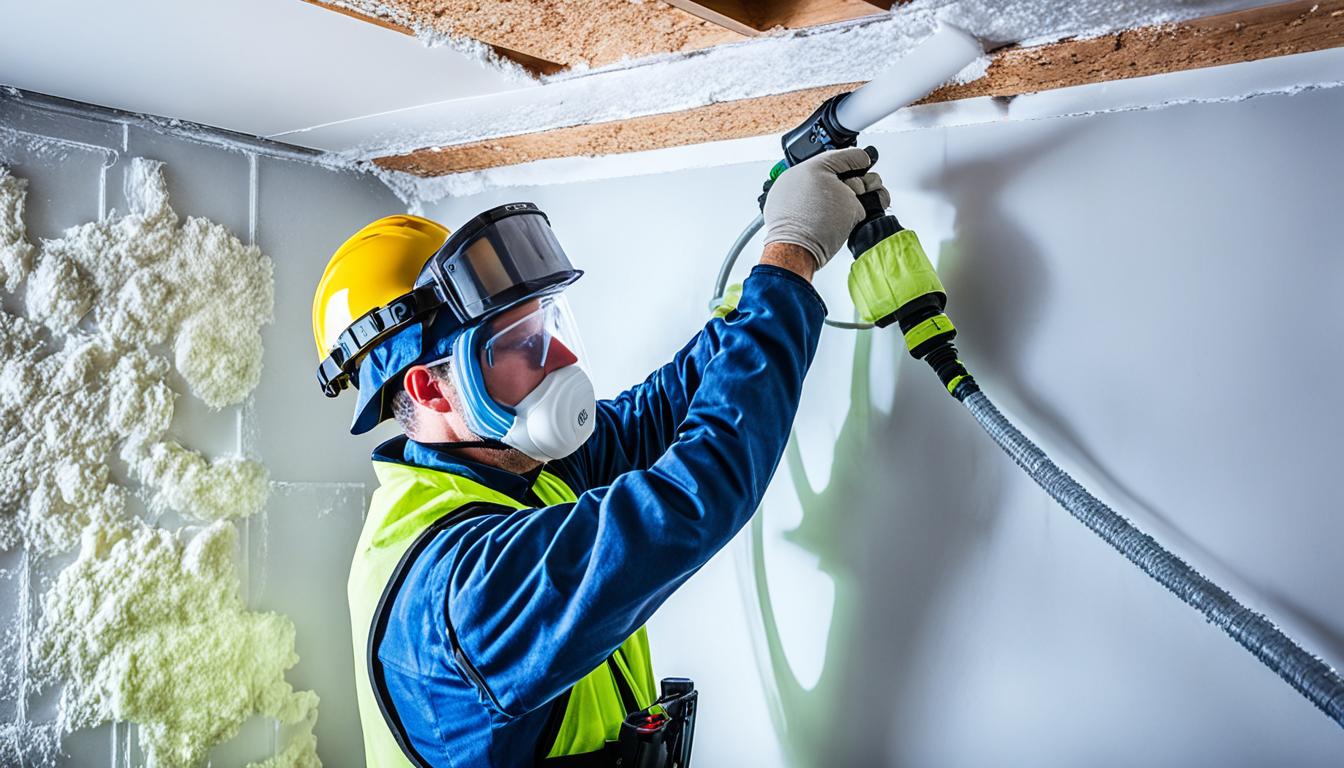How Long Does Spray Foam Take to Dry? Quick Guide for All Projects
Have you ever wondered how long spray foam insulation takes to dry? Many people have the same question. The drying time of spray foam is key in both home and business projects. We'll look at what affects drying time, typical drying times, and safety tips during the curing process.
Ever thought: How long does it really take for spray foam to dry and work fully? The answer might surprise you. Drying time changes a lot based on the foam type and the environment. Let's explore spray foam drying to plan your next project well.
Key Takeaways
- Spray foam drying times can range from a few hours to several days, depending on the type of foam and environmental conditions.
- Closed-cell spray foam generally takes longer to dry than open-cell spray foam due to its denser composition.
- Temperature and humidity levels play a crucial role in the spray foam drying process, with warmer and drier conditions accelerating the curing timeline.
- Proper ventilation and airflow are essential for optimizing the drying of spray foam, ensuring a safe and effective installation.
- Safety precautions, such as wearing personal protective equipment, should be followed throughout the spray foam drying period.
Understanding the Spray Foam Drying Process
Spray foam insulation is now widely used for homes and businesses because it keeps temperatures steady and seals air leaks well. It's important to know how it dries to make sure it's installed safely and correctly. The drying time can change based on temperature, humidity, and the foam type.

Factors Affecting Drying Time
The drying time for spray foam changes depending on the job site's conditions. Cold weather and high humidity slow down drying, while warm and dry conditions speed it up. Good airflow is key to making sure the foam dries right.
Closed-Cell vs. Open-Cell Spray Foam
The foam type also changes how long it takes to dry. Closed-cell foam is denser and insulates better, taking longer to dry. Open-cell foam is less dense and dries faster but doesn't seal as well or insulate as much.
Read More: Closed Cell foam vs Open Cell Foam
Temperature and Humidity Effects on Spray Foam Drying
The temperature and humidity in the area where spray foam is applied greatly affect its drying and curing. For the best results, the temperature should be between 70-80°F, and humidity should be low. These conditions help the foam cure faster.
If it's too cold or too humid, the foam may not dry and cure right. This can weaken the insulation and structure. But, if it's too hot or too dry, the foam might cure too fast, causing issues too.
Good ventilation is key for spray foam to cure well. It keeps the temperature and humidity right. By managing the airflow, contractors can make sure the foam dries and cures properly. This gives the structure the insulation and protection it needs.
Read More: How Long Does Spray Foam Take to Dry?
how long does spray foam take to dry
Typical Drying Times for Residential Applications
The drying time for spray foam varies by application and foam type. Closed-cell spray foam usually takes longer to dry than open-cell foam. For homes, drying times can be a few hours to several days. This depends on the project size and the weather during application and curing.
Commercial and Industrial Spray Foam Drying Durations
Commercial and industrial projects take longer to dry, often over a week. These projects are bigger, so the foam needs more time to set and dry. It's important to keep the right conditions for drying, like good ventilation and temperature control. This ensures a strong and lasting installation.
Proper Ventilation for Optimal Spray Foam Drying
Proper ventilation is key for spray foam application and drying. It helps remove excess moisture and ensures the foam dries evenly. This process keeps the foam insulation strong and long-lasting.
Importance of Adequate Airflow
For spray foam to dry right, it needs good airflow to get rid of moisture. This airflow lets the foam cure fully, making it dense and effective at insulation. Without enough air, the foam might not dry well, leading to problems like poor performance or structural issues.
To help the foam dry well, keep the temperature and humidity right in the area. This setup is perfect for the foam to cure properly and dry evenly throughout the installation.
Read More: Spray Foam Insulation Cost Per sq ft
Safety Precautions During the Spray Foam Drying Period
When installing spray foam, safety comes first, especially when it dries and cures. It's vital to follow spray foam safety precautions to protect installers and building occupants.
Keeping the right spray foam drying conditions is key. This means the temperature and humidity levels are at the right temperature and humidity levels, as the maker suggests. If not, the spray foam insulation curing can be affected, leading to safety risks.
Good ventilation is a must during the spray foam drying period. Installers should make sure the area gets enough air to avoid harmful fumes. This keeps installers safe and makes the building healthier for its future users.
It's important to follow the maker's safety rules during the spray foam installation process. This might mean wearing things like respirators, gloves, and eye gear and following certain safety steps.
By taking these spray foam safety precautions, everyone can make sure the drying and curing go well and safely. This leads to a building that works better and saves energy.
Read More: Can you put drywall over spray foam?
Conclusion
The drying process of spray foam insulation is key for a successful and safe setup. Knowing how temperature, humidity, and the types of spray foam insulation affect curing time helps. This ensures your foam dries right, giving you the insulation and air sealing you need for your home or building.
The curing time for spray foam insulation changes a lot based on different factors. But, following best practices makes installation smooth and efficient. It's important to control temperature, ensure good ventilation, and check on the drying process for the best results.
Remembering these tips lets you confidently start your spray foam insulation project. You'll get lasting energy efficiency and comfort for your space. With the right knowledge and care, your spray foam insulation will work well and last long.
Read More: How many years does spray foam insulation last?
FAQ
How long does spray foam take to dry?
Spray foam drying time varies by type, application, and environment. Closed-cell foam can take from a few hours to several days to dry. Open-cell foam might dry in just a few hours.
What factors affect the drying time of spray foam?
Temperature, humidity, and foam type (closed-cell vs. open-cell) affect drying time. Ideal drying conditions are moderate temperatures and low humidity.
How does the type of spray foam affect drying time?
Closed-cell foam dries slower than open-cell foam. It's denser and needs more time for curing, often taking days. Open-cell foam dries faster in just a few hours.
How long does spray foam take to dry in residential applications?
Drying time in homes varies by foam type and condition. Closed-cell foam takes longer, while open-cell foam dries quicker.
What about the drying time for commercial and industrial spray foam installations?
Commercial projects have bigger areas, so drying takes longer. Times range from hours to days, based on foam type and conditions.
Why is proper ventilation important during the spray foam drying process?
Good ventilation is key for drying and curing spray foam. It removes moisture for a complete cure. It also keeps temperatures and humidity safe.
What safety precautions should be taken during the spray foam drying period?
Safety is crucial during drying. Ensure good ventilation, keep temperatures and humidity safe, and follow the manufacturer's guidelines. This protects installers and building occupants.




